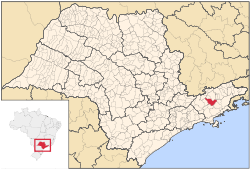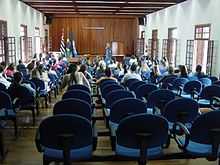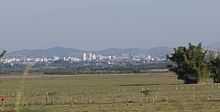Taubaté
| Município de Taubaté Taubaté | |||
|---|---|---|---|
 | |||
| |||
| Motto: Per aspera pro Brasilia<br/ small> All sacrifice for Brazil | |||
 | |||
| Coordinates: 23°01′30″S 45°33′20″W / 23.02500°S 45.55556°W | |||
| Country | Brazil | ||
| Region | Southeast | ||
| State | São Paulo | ||
| Government | |||
| • Mayor | José Bernardo Ortiz Júnior (PSDB) | ||
| Area | |||
| • Total | 625.9 km2 (241.7 sq mi) | ||
| Population (2008) | |||
| • Total | 278,724 (2,010)[1] | ||
| • Density | 436.8/km2 (1,131/sq mi) | ||
| Time zone | UTC-3 (UTC-3) | ||
| • Summer (DST) | UTC-2 (UTC-2) | ||
| Postal code | 12000-000 | ||
| Area code(s) | +55 12 | ||
| Website | www.taubate.sp.gov.br | ||
Coordinates: 23°02′00″S 45°33′00″W / 23.03333°S 45.55000°W Taubaté is a medium-sized city in the State of São Paulo, in southeastern Brazil. Its strategic geographical location, between the two most important Brazilian cities (São Paulo (123 km) and Rio de Janeiro) (280 km), being crossed by Presidente Dutra Highway which connects the two megacities and is directly connected to São Paulo via SP-070 also called Rodovia Governador Carvalho Pinto, and between high, cold mountains and the Atlantic Ocean has helped the development of the city. The city has around 300,000[1] inhabitants and has become an industrial center, seating branches of several companies, including Volkswagen, Alstom, Ford, LG, Embraer, among many others.
History

Taubaté was part of the ancient Tupinamba Territory, along the Paraiba do Sul River. The Tupinamba Territory in the 16th century, stretched from the Juqueriquerê River on the shores of Caraguatatuba to the Cape of Saint Thomas (Cabo de São Tomé) in the State of Rio de Janeiro. The first village was created in 1640 being proclaimed as an autonomous locality on December 5, 1645, by a pioneer named Jacques Felix. It was the first location in the Vale do Paraiba region to obtain autonomy. The locality got its current city status in 1842. By that time, it was one of the most important coffee production centers in the country, hosting the Taubaté's Agreement in 1906. In 1908, the city was made the seat of the Roman Catholic Diocese of Taubaté. In 1900 was the largest city in the interior of São Paulo.
The county name comes from the Tupi language and means village (taba) high (ybaté).
In 1891, Taubaté was one of the first cities in Brazil to industrialize. With the CTI (Companhia Taubaté Industrial), a Textile Industry.
Weather
| Taubaté | ||||||||||||||||||||||||||||||||||||||||||||||||||||||||||||
|---|---|---|---|---|---|---|---|---|---|---|---|---|---|---|---|---|---|---|---|---|---|---|---|---|---|---|---|---|---|---|---|---|---|---|---|---|---|---|---|---|---|---|---|---|---|---|---|---|---|---|---|---|---|---|---|---|---|---|---|---|
| Climate chart (explanation) | ||||||||||||||||||||||||||||||||||||||||||||||||||||||||||||
| ||||||||||||||||||||||||||||||||||||||||||||||||||||||||||||
| ||||||||||||||||||||||||||||||||||||||||||||||||||||||||||||
Demographics
Male: 120.288; Female: 123.819; Urban: 229.810; Rural: 14.297 (Source: Censo 2000 - IBGE)

Education and Literature


Taubaté is also a university city. The University of Taubaté, UNITAU, is an municipal institution of higher learning run by the state, but also by the private initiative. Brazil, like France, is a country where state-owned universities are free and rank as the best, but UNITAU isn't free. UNITAU attracts young people from all over the country who come to study in one of its many colleges, such as Medical School, Law, Dentistry, Engineering, Business Management, and also at the Department of Architecture where several alumni have excelled and won national prizes for their work, notable the Opera Prima Award.
Monteiro Lobato, reputedly one of the most significant Portuguese-language writer of books for children was born in Taubaté. His books have been translated into many other languages, especially Sítio do Picapau Amarelo, the first and one of the largest tomes in the series of twelve.
The unique way in which the narrative unfolds, gripping as they are for the many generations of children - and adults - who have read them, evolves in a style which can be likened to the sort of magic realism that permeates later styles of Latin American literature, and is set in rural São Paulo State where legends and myths naturally abound as the Portuguese colonial culture is fertilised by the fusion of amerindian and African cultures. The scene of his books is a fictional small farm - the Sítio do Picapau Amarelo ( loosely translated as the Yellow Woodpecker Estate) owned by the central character to all of M L's books, one Dona Benta, a cultivated widow living alone in the farmlet with her black female servant Nastácia. Dona Benta's grandchildren spend their summer holidays with her and most stories revolve around that scenario, which incidentally was inspired in M L's own property.
José Bento de Monteiro Lobato was the grandnephew of the Viscount of Tremembé, a historical figure who lived in the region of Taubaté during the second half of the 19th century, in the days when Brazil, a constitutional monarchy independent from Portugal, was an expanding economy largely dependent on its coffee plantations.
Another very important man in Taubatean and Brazilian history was Amacio Mazzaropi who was one of the pioneers in the movie industry, creating many classics that show a rural Brazil in the first half of the 20th century. Mazzaropi embodies what might be described as a rural Brazilian stereotype, the Jeca - a dude -whose emotions and sentiments are universal but which nevertheless reflect his immediate environment and culture. Mazzaropi the actor and film maker was himself epitomic of another influence in that part of the country: the son of Italian immigrants who falls in love with his new homeland, although, it must be said, none of his rôles reflects this, since what Amacio endeavoured to portray at all times was the somewhat raw, idillyc and also very dainty environment of the coffee growing regions of his birthplace and their pretty cities in the lush tropical landscape.
Sports
Esporte Clube Taubaté is a football club based in the city.
Quality of life


Sister cities
External links
| Wikimedia Commons has media related to Taubaté. |
- (Portuguese) Official website
- (Portuguese) Page About the city of Taubaté

